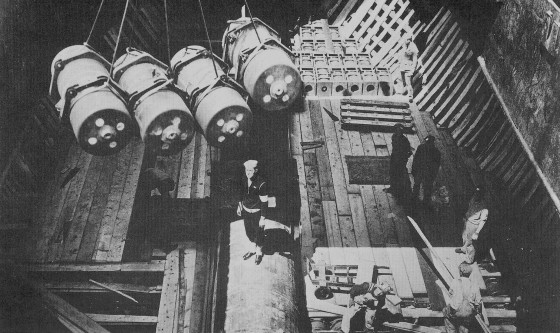
The SS El Estero. A member of an Explosives Loading Detail monitors the loading of high explosives and the work of carpenters as they construct the bombs’ wooden framework in the ship’s hold. U.S. Coast Guard photo. The ensuing explosion and fire put the entire New York harbor in danger. For the full story click here.
By: Phil Kohn. Dedicated to the memory of his father, GM3 Walter Kohn, U.S. Navy Armed Guard, USNR, and all men and women who have answered the country’s call in time of need. Phil can be contacted at ww2remembered@yahoo.com.
In Tunisia on April 23, 1943, after fierce fighting, the British break through the German lines at Longstop Hill, south of Tunis, and take the position. Tactical surprise is provided by the Churchill heavy tanks of the British Army’s North Irish Horse, which climb the steep sides of the hill to the disbelief and dismay of the Axis defenders.
At Bayonne, N.J., on April 24, the cargo ship SS El Estero, having just taken on 1,365 tons of mixed munitions at the U.S. Army’s Caven Point Depot, catches fire and begins drifting through the harbor after burning through the lines securing it to its dock. (Also at the dock are two other fully loaded ammunition ships as well as two ammunition trains.) Aboard El Estero are 60 Coast Guard volunteers fighting the fire. The Fire Department of New York’s largest fireboats — Fire Fighter and John J. Harvey — and three commercial tugboats spend seven hours catching the vessel, moving it to more-open waters, and, finally, flooding it with enough water to sink it, averting what could have been a devastating explosion in the heart of New York Harbor.
On Easter Sunday, April 25, the U.S.S.R. breaks off diplomatic relations with the Polish government-in-exile in London over allegations of Soviet complicity in the massacre of Polish army officers and others at Katyn Forest. American bombers attack Bari, in the south of Italy.
In Tunisia, the British First Army’s V Corps passes Longstop Hill and reaches Djebel Bou Aoukaz, on the approach to Tunis, on April 26. The aircraft carrier USS Intrepid is launched at Newport News, Virginia. It will be commissioned August 16.
The Allied convoy ONS-5, sailing from Liverpool, England to Halifax, Nova Scotia, on April 27 begins a seven-day running battle against 51 German U-boats. The convoy achieves considerable success, despite limited air support, sinking 7 U-boats and damaging 17, versus the loss of 13 of its 42 merchant ships. In Tunisia, the Germans counterattack at Djebel Bou Aoukaz, and retake the position. Because of German labor needs, Heinrich Himmler orders concentration camps not to kill people who can work, while giving priority to the killing of “the mentally ill who could not work.”
On April 28, British forces repulse a desperate Panzer counterblow in Tunisia. In the Pacific, the Imperial Japanese Navy troop transport Kamakura Maru, sailing from Manila with 2,500 aboard, is torpedoed and sunk by the submarine USS Gudgeon. The ship goes down within 12 minutes, taking 2,035 people with it.
April 29: Off the coast of West Africa, German submarine U-515 sinks five Allied ships on this one day.



